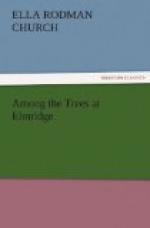“Pignut is another beautiful name,” said Malcolm, who was disposed to be critical. “Do pigs ever eat the nuts, Miss Harson?”
“I dare say that they do when they have the chance,” was the reply, “as they delight in nuts; but that is said not to be the proper name for the species. Some of the nuts are shaped like a fresh fig, and ‘fig-nut’ seems to be the name originally intended. But there is a great variety in the shape of the nuts, as some are nearly round and others very irregular. They are alike, however, in having very hard, tough shells, and the kernel is not pleasant enough to repay the trouble of getting at it. These nuts are very apt to grow in pairs, and several bushels of them can be gathered from one tree.”
“Aren’t they good to eat?” asked Clara.
“Not at all good,” replied her governess, “except to those who are not particular about what they eat; and this may be the reason for calling them ‘pignuts,’”
“Bitternut doesn’t sound much better,” said Malcolm, again. “I wonder what that species has to say for itself?”
“Not very much, I am afraid, for it is sometimes called the bitter pignut, and even boys will not eat it, while squirrels refuse to feed on it when any other nut can be found. The shell of this nut is so thin that it can be broken in the fingers, but, as no one cares to break it, it is safer than many a thicker shell. It is intensely bitter, and well deserves its name. The tree, however, is handsome and the most graceful of all the hickories; the small, slender leaves give it the look of an ash, and the trunk is smoother than that of most large trees. In summer the finely-cut foliage is of a bright green, and in autumn it changes to a rich orange, which lasts after the other species have become russet and brown.”
“Is there anything more about hickory trees?” said Clara.
“Only to speak of the great value of the wood,” replied Miss Harson. “Its uses are almost endless. Great numbers of walking-sticks are made of it, as for this purpose no other native wood equals it in beauty and strength. It is next in value to white oak for making hoops; it makes the best screws, the smoothest and most durable handles for chisels, augurs, gimlets, axes, and many other common tools. As fuel, hickory is preferred to every other wood, burning freely, making a pleasant, brilliant fire and throwing out great heat. Charcoal made from it is heavier than that made from any other wood, but it is not considered more valuable than that of birch or alder. The ashes of hickories abound in alkali, and are considered better for the purpose of making soap than any other of the native woods, being next to those of the apple tree.”




